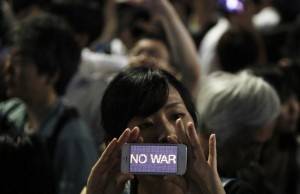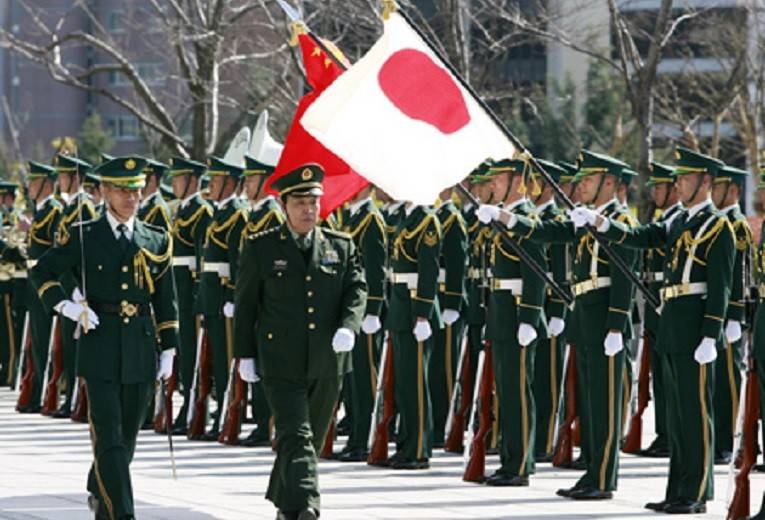Japanese Military No Longer Dormant
Prime Minister Shinzo Abe’s plan to modify Japan’s self-defense laws, which are almost certain to become law this year, has provoked a new round of concerns that Japanese militarism — dormant since the Second World War — may be returning. The change would allow the Japanese military to come to the aid of allied countries, such as the United States, that are under attack, formally extending Japan’s military capabilities beyond self defense, for the first time after nearly seven decades.
But while Abe’s proposal marks a formal shift away from Japan’s commitment to pacifism, the prime minister was quick to downplay the possibility that the new law will make Japan likelier to go to war. At a press conference, Abe told reporters that belligerence would not happen.
“We will not use force for the sole purpose of defending another country,” he said.

Not everyone is convinced. In China’s state-run People’s Daily, an editorial criticized the shift as a sign of a “re-emergent fascism” and warned that it could destabilize the Asia-Pacific region.
“It’s up to Japan to explain clearly to its neighbors why it is doing this, and why this is good for regional and global security,” the editorial said.
Following its surrender in World War II, Japan agreed to a U.S.-drafted constitution that prohibited its military from engaging in operations aside from self-defense, and an alliance formalized with the United States in 1960 has underpinned Japanese foreign policy in the decades since. But China’s increasing military strength — and Beijing’s corresponding assertiveness in pursuing territorial claims on its maritime periphery — has shifted the balance of power in the Asia-Pacific region.
China and Japan are currently embroiled in a dispute over the Senkaku Islands (called “Diaoyu” in China), an archipelago thought to contain significant energy resources in its surrounding waters. In 2012, Shintaro Ishihara, a right-wing governor of Tokyo, angered Beijing by agreeing to purchase the islands from a private Japanese citizen. (Ultimately, the national Japanese government bought the islands instead — but this failed to mollify China). The following year, China established an air-defense identification zone (ADIZ) requiring aircraft to notify the Chinese military when flying near the islands. A provocation on either side risks military conflict, one that would also involve the United States, which is bound by treaty to defend Japan.
Any revision in Japan’s constitution, then, is bound to heighten tension. But Abe’s constitutional shift does not alter the balance of power in the region. According to Sheila Smith, a Japan expert at the Council on Foreign Relations, the reinterpretation allows for greater efficiency and coordination between the United States and Japan in the event something happens.
And despite China’s official condemnation, Abe’s signal likely comes as little surprise in Beijing, which has never, due in part to historical factors, taken Japanese pacifism for granted.
“China has not been persuaded that Japan’s constitutional debate would get into the way of alliance cooperation [with the United States],” she said.
Abe’s persistence in altering Japan’s constitution reflects a gradual move away from the postwar alignment in East Asia. Pacifism is hardly dead in Japan — thousands protested the proposal on Monday and Tuesday in Tokyo, with one man even setting himself on fire. But the era in which each Japanese government accepts the military limits of its constitution now appears to be over.
“Japan is experiencing a security renaissance,” Andrew L. Oros, director of international studies at Washington College in Chestertown, Maryland, told the New York Times.
Last year, as Mr. Abe readied to govern, and Japanese re-militarization was put on the policy agenda, The Global Think Tank sought to assuage any concerns. We reprint the article, below
DO NOT FEAR JAPANESE RE-MILITARIZATION
As Japanese Prime Minister Shinzo Abe settles into what most expect will be a multi-year term in office (something not realized in a decade), attention turns to his ambitious defense reform agenda including more spending, a new National Security Council apparatus, loosening legal restrictions on the use of troops and weapons, and possibly revising Japan’s “war-renouncing” constitution. Critics worry thatJapan could stoke an arms race in East Asia with a policy of “remilitarization” and right-wing nationalism, but we should avoid exaggerating what the Japanese people will allow.
Concerns about Japanese remilitarization and nationalism are not new, as they have surfaced almost every decade since the 1970s, whether it was a push by Yasuhiro Nakasone for big defense budget increases (1970s and 1980s), Japan’s first post-WWII dispatch of military personnel (1990s), or Prime Minister Junichiro Koizumi’s visits to Yasukuni Shrine and active support of the Iraq War (2000s). Abe’s efforts, like the others, will result only in incremental changes that primarily compensate for new defense realities.
By some measures, Japan already has a potent military. It has the world’s fifth largest defense budget (in US$) and is looking to increase spending and personnel in coming years. In yen terms, however, Japan’s budget remains below where it was in 2000, and the proposed personnel increase is only 300 soldiers. Given recent yen weakness, expect Japan’s defense budget to fall to number eight next year, behind India. Overall, with a two percent inflation target and only a plan for one percent defense spending increases, Japan’s policy is for real defense spending decline.
In addition, Japan does not get much for money spent on defense, due to an inefficient procurement system and an addiction to high-end gadgets. Japan will spend over $500 million in 2013, for example, for just two F-35 fighter aircraft. That is almost ten percent of its overall procurement budget and one-third of the aircraft acquisition budget.
Japan does have high-level military capabilities, but a myriad of laws restrict when and how they can be used. Japan continues to rule out any use of force beyond the minimum necessary for self-defense. What restrains Japan on this front is a combination of history (past wars and the Constitution), politics (voter sentiment and regional opposition), and strategic choice (prioritizing economic growth and trade).
The Abe Cabinet might want to make different strategic choices, but increased voter concern about North Korean or Chinese threats is marginal, and legal restrictions on Japanese remilitarization are rigid. Moreover, budget constraints are real, with almost one-quarter of the general account spent on debt servicing: Japan cannot afford to make drastic changes to its defense policy.
So, prepare to see steady defense funding without large increases, but with more focus on intelligence, surveillance, and the island’s outer defense. We might even see a loosening of restrictions on Japan exercising its right of collective self-defense, which could make it a better partner in multilateral (primarily UN) security cooperation missions. We are unlikely to see constitutional revision or a significantly more potent Japanese military. Even this modest outcome, however, will elicit complaints from neighboring countries, so careful explanation is required
 The Global Calcuttan Magazine
The Global Calcuttan Magazine 